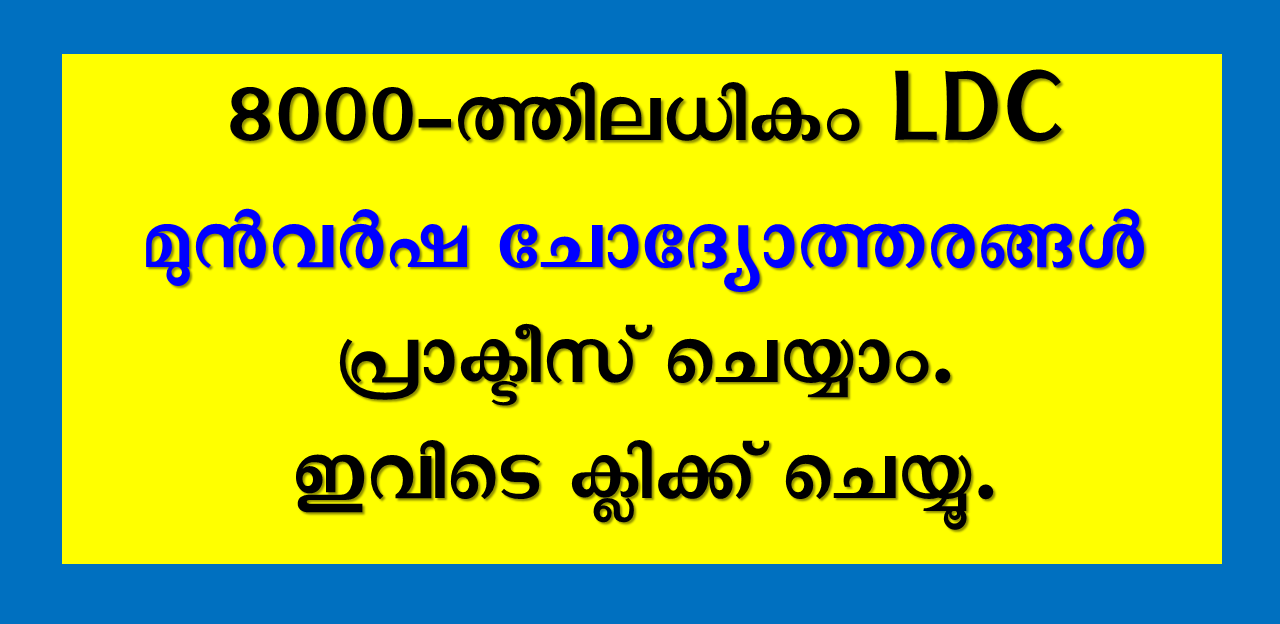PSC Previous Questions For KSRTC Civil Assistant Engineer : [Part 3]
Here is the Part 3 of the PSC Previous questions and answers for Kerala State Road Transport Corporation Civil Assitant Engineer examination held in 2013. You may also download the whole 100 questions in PDF format with solved answers.
More About Exam:
Exam: Assistant Engineer
Category Number: 139/2012
Exam Date: 2013-09-07
Total Question: 100
KSRTC Assistant Engineer Previous Questions & Answers – 41 to 60
Question 41: The direction of flow of liquid in a propeller pump impeller is in
(a) outward radial direction
(b) axial direction
(c) inward radial direction
(d) the direction tangential to the impeller
Ans: (b) axial direction
Question 42: The ratio of volume to the total volume of the given soil mass, is known as:
(a) porosity
(b) void ratio
(c) specific gravity
(d) water content
Ans: (a) porosity
Question 43: Dry density of soil is:
(a) D10
(b) D30
(c) D20
(d) D40
Ans: (a) D10
Question 44: A soil having uniformity coefficient more than 10 is called
(a) Uniform
(b) fine
(c) coarse
(d) well graded soil
Ans: (d) well graded soil
Question 45: Dry density of soil is
(a) always greater than the saturated density
(b) ratio of the weight of soil solids to the volume of solids
(c) ratio of the weight of soil solids to the total volume
(d) determined by strength test
Ans: (c) ratio of the weight of soil solids to the total volume
Question 46: The property of a soil which permits flow of water through its interconnected voids is called
(a) seepability
(b) porosity
(c) permeability
(d) void ratio
Ans: (c) permeability
Question 47: The functional equation for specific gravity G, water content w, void ratio e and degree of saturation Sr is
(a) w=Sr G/e
(b) e= Sr w/G
(c) Sr= wG/e
(d) G=Sr w/e
Ans: (c) Sr= wG/e
Question 48: The law states that in laminar flow in a saturated soil, the velocity is directly proportional to the hydraulic gradient is called
(a) Reynold’s law
(b) Bligh’s law
(c) Darcy’s law
(d) Lacy’s law
Ans: (c) Darcy’s law
Question 49: The gradual reduction in volume of a soil mass resulting from an increase in and continued application of compressive stress and is due to expulsion of water from the pores is called
(a) Compaction
(b) consolidation
(c) settlement
(d) depression
Ans: (b) consolidation
Question 50: The minimum size of plate in plate load test is:
(a) 100 mm
(b) 450 mm
(c) 200 mm
(d) 300 mm
Ans: (d) 300 mm
Question 51: Bearing capacity should be calculated from the criteria of
(a) shear only
(b) settlement only
(c) both settlement and shear
(d) cohesion only
Ans: (c) both settlement and shear
Question 52: Floating foundation is a type of:
(a) well foundation
(b) pile foundation
(c) pier foundation
(d) raft foundation
Ans: (d) raft foundation
Question 53: A shallow foundation is a foundation that
(a) has low bearing capacity
(b) has a depth of embedment less than its width
(c) is resting on the ground surface
(d) causes less settlement
Ans: (b) has a depth of embedment less than its width
Question 54: Diameter of a circular footing is 3m and side of a squre footing is 3m. Both the footing are soil (c-ø) at same depth. The ultimate bearing capacity of circular footing is:
(a) less than squre footing
(b) more than square footing
(c) same as square footing
(d) not comparable
Ans: (a) less than squre footing
Question 55: The energy stored in a material within elastic limit when it is under strain is called:
(a) impact
(b) shock resistance
(c) resilience
(d) elasticity
Ans: (c) resilience
Question 56: The property of a material enabling it to resist dformation under stress is called:
(a) toughness
(b) stiffness
(c) strength
(d) brittleness
Ans: (b) stiffness
Question 57: The rate of change of blending moment is equal to
(a) shear force
(b) deflection
(c) slope
(d) axial thrust
Ans: (a) shear force
Question 58: The point in a beam whre the shear force changes sign is called the point of
(a) Maximum BM
(b) zero shear
(c) zero curvature
(d) maximum curvature
Ans: (a) Maximum BM
Question 59: For a simply supported beam, carriying a uniformly distributed load, the shape of the bending moment diagram will be,
(a) triangular
(b) parabolic
(c) circular
(d) cubical
Ans: (b) parabolic
Question 60: A cantilever beam of length L, cross-section A is subjected to a total uniformly distributed load of W and a concentrated load W1 at a distance L1 from free end will have maximum moment of
(a) (WL/2) + W1 L1
(b) (WL2/2) + W1 L1
(c) [W(L-L1)/2] + W1 L1
(d) (WL/2) + W1 (L-L1)
Ans: (d) (WL/2) + W1 (L-L1)




